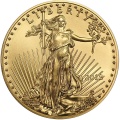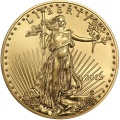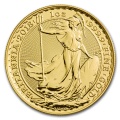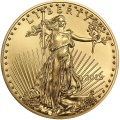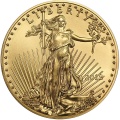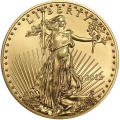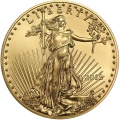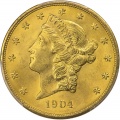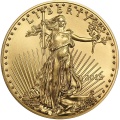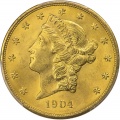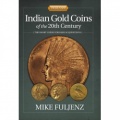August 2020 - Week 2
Major Mutual Fund CEO Predicts $4,000 Gold
On Monday, August 10, Frank Holmes, CEO of U.S. Global Investors, told investors watching CNBC, the most popular financial TV network, “It’s quite easy to see gold going to $4,000.” He pointed to the trillions of dollars in stimulus packages passed by Congress during the coronavirus pandemic. He added that the other G-20 finance ministers and central banks are “working together like a cartel and they’re all printing trillions of dollars” and “at zero interest rates, gold becomes a very, very attractive asset class.”
Holmes has long maintained that “negative real interest rates” (no real income after inflation) are the key indicator fueling gold’s rise, so a looser monetary policy generally means investors are more likely to seek out gold as savings. In this scenario, the “opportunity cost” of holding gold disappears for investors. Last week, the U.S. 10-year bond reached a record low yield of 0.5%, as close to zero as it is likely to get.
Now is Not the Time to Sell
In times past, gold “spiked” to a peak and then fell back, so that the peak would have been a good time to sell bullion. That is probably not the case this time. Gold has not spiked to a sharp peak, this time around, as it did in 1979-80. This rise has taken five years and this last rise has been gradual. The 2011 rise from $1,500 to $1,900 was fairly sharp, but gold prices stayed above $1,500 for another 18 months in that case.
The main reason to stay with rare coins is that they tend to keep rising, as they lag the bullion market. It takes time (about six to 18 months) for many of the new masses of bullion investors to “graduate” to the numismatic market and start bidding up the rare gold and silver coin market. Far from selling any rare coins, now is the time to finish accumulating any key numismatic sets that you may have already started building. Important rare coins are likely to increase in price over the next two to four years, well after bullion prices have peaked.
As for the bullion market, I believe there is still plenty of room left to rise. One major concern is that the gold market has consistently risen for nine straight weeks without a major correction. Technically, the charts and market momentum still suggest the price of gold and silver will move higher, but it is natural to see corrections along the way, so we should not be discouraged when such corrections occur. As of Tuesday afternoon, gold has pulled back to $1,917 and silver has receded to $25.20.
Why do I think gold will continue to rise? In addition to supply and demand fundamentals, there are the unique outside threats. In addition to coronavirus concerns, the 2020 Presidential elections are certain to be contested; U.S./China trade tensions remain high, and China’s belligerence against Hong Kong and Taiwan continues, as Mainland China’s military jets reportedly flew over Taiwan’s air space last week.
This year has already seen a “perfect storm” of domestic and global threats. There is no end in sight, and the gold market has reflected those realities for the last six months.
Silver is More Volatile than Gold – Like “Gold on Steroids”
Gold pierced the $2,000 “barrier” last week and stayed above $2,000 all week, reaching a record high of $2,078. Silver soared to $29.90 before correcting – an amazing 149% run from barely $12 last March. The gold-to-silver ratio had dropped from 125-to-1 in March to a historically normal 70-to-1 Monday.
Silver’s rapid rise to $29 is not without precedent. In 2011 as well as 1980, silver spiked to nearly $50 an ounce when gold was rising at a more moderate pace. The major reason for silver’s more rapid rise is that it is a much narrower market, so that the same amount of money entering the silver market will drive it much higher than the gold market, on a percentage basis. When the metals markets are rising, silver will often attract more money since it is more affordable to more investors than the higher-priced gold.
Brokerages are starting to back silver: TD Securities said that “Silver continues to outperform and remains our precious metal favorite.… strong investment flows and robust industrial demand combine for strong performance at a time when the microstructure creates a disincentive for silver bullion traders to sell.”
Here are some of silver’s fundamental market advantages over gold from a trading perspective
Smaller Supply: The annual supply of new silver is around one billion ounces, while the annual supply of gold is 120 million ounces. Using the start-of-year prices of $1515 gold and $18.04 silver, that’s about $18 billion in silver vs. over $180 billion in gold – or 10 times as much gold capitalization as silver.
This explains why silver is far more volatile than gold. If $10 billion moved into the silver market, it would push silver prices up sharply, but it would only move gold up slightly, and it probably wouldn’t budge Apple stock. Both gold and silver are tiny specks of stock market dust compared to stocks like Apple, now worth $2 trillion – or Microsoft or Amazon.com, worth $1.6 trillion each. It takes 10 years of newly mined gold and silver to equal the market value of Apple, so precious metals are still grossly undervalued.
Affordability. Another reason silver moves faster than gold is that more investors can afford silver than can afford gold. That’s why it’s called “poor man’s gold.” This was the basis of the Presidential elections of the 1890s – the silver (or bi-metallic) standard vs. gold standard. The Eastern establishment favored the gold standard, but the western farmers and miners could not afford to buy even a single ounce of gold.
The Democratic candidate William Jennings Bryan criticized the gold standard and favored inflating the currency by the free coinage of silver, which gained favor in that deflationary age among the debt-ridden farmers whom Bryan championed. In 1896, he gained fame his speech, ending: “You shall not press down upon the brow of labor this crown of thorns. You shall not crucify mankind upon a cross of gold.”
Industrial demand. Silver also has far more industrial uses than gold, so when the global economy recovers, silver should perform better than gold, but that angle is not in play this year. In normal times, silver demand is 60% industrial and 40% investment. This year, silver’s investment angle has prevailed.

Important Disclosure Notification: All statements, opinions, pricing, and ideas herein are believed to be reliable, truthful and accurate to the best of the Publisher's knowledge at this time. They are not guaranteed in any way by anybody and are subject to change over time. The Publisher disclaims and is not liable for any claims or losses which may be incurred by third parties while relying on information published herein. Individuals should not look at this publication as giving finance or investment advice or information for their individual suitability. All readers are advised to independently verify all representations made herein or by its representatives for your individual suitability before making your investment or collecting decisions. Arbitration: This company strives to handle customer complaint issues directly with customer in an expeditious manner. In the event an amicable resolution cannot be reached, you agree to accept binding arbitration. Any dispute, controversy, claim or disagreement arising out of or relating to transactions between you and this company shall be resolved by binding arbitration pursuant to the Federal Arbitration Act and conducted in Beaumont, Jefferson County, Texas. It is understood that the parties waive any right to a jury trial. Judgment upon the award rendered by the Arbitrator may be entered in any court having jurisdiction thereof. Reproduction or quotation of this newsletter is prohibited without written permission of the Publisher.

